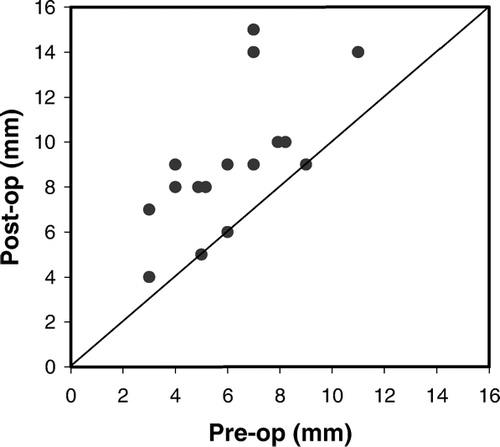Congenital ptosis has been treated by transcutaneous anterior levator resection (ALR) for over half a century (Burke, 1959). Sixteen primary ALRs were performed in 15 patients for simple congenital ptosis. Assessment of levator function was confirmed on two occasions preoperatively, measured from downgaze to upgaze in millimeters (frontalis action excluded) and confirmed by independent observers (Boboridis et al., Citation2001). Surgery was carried out by a single surgeon using a standard technique (Collin, Citation1989). Levator function improved in 13/16 operations and did not improve in 3 (). Average levator function preoperatively was 6.1 mm (range 3–11) and improved postoperatively to 9 mm (Wilcoxon rank p < 0.001, range 4–15). Eighty percent of the ALRs had improved levator function (mean = 2.9 mm, range 0–8). Follow-up averaged 2 years 3 months (range 3–60 months). The only patients requiring re-operation were 2 patients without levator function improvement.
FIGURE 1 Levator function improved in 13/16 anterior levator resections for simple congenital ptosis. Three out of 16 did not improve and are plotted on the line of no change.

In normal eyelids, dynamic imaging has shown a close relationship between levator contraction and upper lid elevation (Ettl et al., Citation1998). Although increased levator function following ALR has been reported in 40% of cases in one series (Johnson, Citation1954) and 80% of cases, with an average improvement of 2.2 mm seen, in another (Berke, Citation1959), since these reports, both from the 1950s, levator function improvement following ALR has not been documented. Improvement in levator function is beneficial for cosmesis because it reduces asymmetry in up- and downgaze. Excision of dystrophic tissue and/or an improved mechanical advantage might explain these observed changes in levator function. Our small series of cases serves to remind surgeons that increased levator function can underpin a successful outcome.
REFERENCES
- Berke R. Results of resection of the levator muscle through a skin incision in congenital ptosis. AMA Arch Ophthalmol 1959; 61: 177–201
- Boboridis K, Assi A, Indar A, Bunce C, Tyers A G. Repeatability and reproducibility of upper eyelid measurements. Br J Ophthalmol 2001; 85: 99–101
- Collin J. A Manual of Systematic Eyelid Surgery. Churchill Livingstone, Edinburgh 1989
- Ettl A, Daxer A, Priglinger S, Kramer J, Koornneef L. Dynamic magnetic resonance imaging of the levator palpebrae superioris muscle. Ophthalmic Res 1998; 30: 54–58
- Johnson C. Blepharoptosis: A general consideration of surgical methods with results in 162 operations. Am J Ophthalmol 1954; 38: 129–162